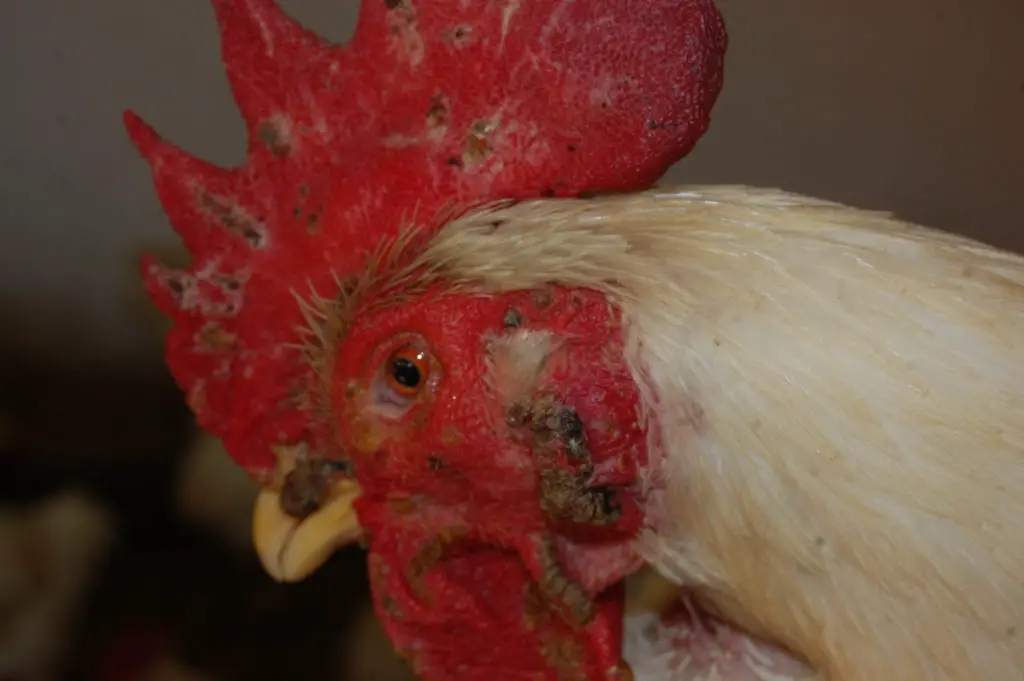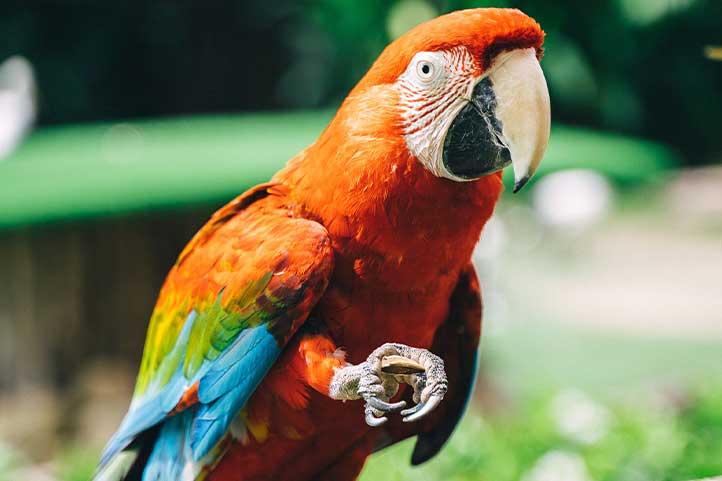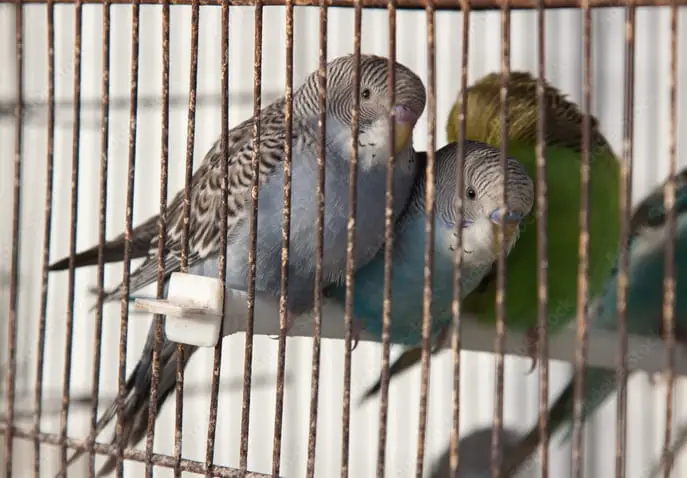Translated by Nick R
Birds are very strong animals that sometimes are difficult to detect when they get sick, as they are great at hiding it. However, your bird’s health and well-being are in your hands, so read the following rules carefully and get instructed to identify the first signs of illness and act in time.
Table of Contents
1. Abnormal droppings of your bird
The characteristics of your bird’s droppings can change due to variations in diet, so pay attention to any changes that imply illness or discomfort in your bird.
How to identify it?
To detect if your bird’s droppings are not normal and require veterinary attention, look for the following signs in stools:
Color
If their droppings are reddish, yellow, green or black, get concerned.
Consistency
When the stool texture is too soft or too hard it indicates digestion problems.
Appearance
When the appearance of the stool shows a lot of liquid or blood, it sets off alarm bells. In this case, it could range from dehydration to more serious illnesses.
Which diseases could be involved?
Some of the most common diseases associated with these signs are:
- Coccidiosis. This disease is caused by the protozoan genus Eimeria, a host-parasite that destroys the intestinal epithelium.
- Fowl cholera. Contagious bacterial disease caused by Pasteurella multocida that attacks the organs, producing necrosis (tissue death) in more severe cases.
- Ascaridiosis. Infection caused by the nematode of the genus Ascaridia.
- Avian influenza. A disease caused by the influenza virus type A that affects the respiratory tract and intestines.
- Salmonellosis. Bacterial infection affecting the intestinal tract is caused by bacteria of the genus Salmonella.
What should I do?
Monitoring the droppings can prevent serious illnesses in your bird. If you notice any of the above symptoms in his feces, take him to the veterinarian immediately.
Some diseases can be managed with basic daily care such as feeding and hygiene, but others require specialized care and must be treated by a veterinarian. For this reason, you can’t miss the daily check-up that you can do during morning grooming.
2. Check your bird’s feathers
The plumage of your bird is essential in all its life cycle; apart from one of its main physical traits and flying, they serve to detect diseases and thus will serve as a compass to guide you in caring for your bird.
How to identify it?
To identify signals of your bird’s health in his feathers, pay close attention to the following manifestations of diseases:
Feather loss
Feather loss, more than usual. The situation is much more worrisome at times when they don’t molt normally, as they should not lose feathers frequently.
Plumage changes
Changes in the brightness, texture, and color of the plumage; less bright and colorful feathers.
Reddening of the skin
Reddening of the skin under the feathers occurs when the bird suffers from itching and scratches desperately.
Lumps and malformations
Lumps or malformations under the feathers, especially when they are in molting season.
Wounds
Wounds or lacerations under the feathers.
What diseases could be involved?
These signs could be associated with diseases such as:
- Abnormal molts. This disease occurs when the bird molts during seasons that are not naturally due.
- Follicular cyst. This occurs when feathers grow into the bird’s body and is caused by a congenital disease (before birth).
- Pododermatitis. It is a bacterial disease that doesn’t affect the feathers directly, but the skin, causing the feathers to fall off.
- Polyomavirus. It’s caused by the viral family of Polyomaviridae that leads to feather loss, with high mortality in young birds.
- Acariosis. Caused by mites, external parasites that affect the skin and feathers.
What should I do?
The various feather-borne diseases can affect both feathers and other parts of the bird’s body. These diseases may be caused by parasites or simply infections and skin problems. Some can be fatal, such as polyomavirus, while others, such as acariosis, are not.
Also, keep in mind that birds often get encrusted feathers when they are molting, so new feathers won’t always come out well. Check your bird’s plumage periodically.
The hygiene of the bird and its environment is fundamental to avoiding most of the diseases that affect its plumage and skin. If symptoms persist, take it to the veterinarian immediately.
Additionally, include more vitamins in its diet, which are necessary for the good health of its feathers.
3. Your bird’s feeding habits change.
Watch your bird’s feeding and water consumption habits, especially loss of appetite, which is a key sign that something is wrong. Your bird’s appetite is affected by the following symptoms:
How to identify it?
Lack of appetite.
Not eating the same amount of food as before or no longer eating what it used to like.
Weight loss
You notice weight loss and the bird’s breast becomes more notable, in such a way that when you lift the plumage you can see the bone.
Low mood
Your bird’s mood is increasingly low. This happens due to a lack of food, the bird will be weak and tired.
Very thirsty
You notice that it is suffering from excessive thirst. If you notice your bird drinking more water than usual, be careful. While water is beneficial to the body, excessive thirst is a bad symptom.
What diseases could be involved?
When your bird is unwell or afflicted by disease, lack of appetite may be an indicator. Here are some of the most common diseases:
- Avian coryza. An acute respiratory disease caused by the bacterium Avibacterium paragallinarum.
- Typhoid. Septicemic disease (infection by bacteria in the blood) is caused by the bacterium Salmonella Gallinarum.
- Colibacillosis. A digestive disease that can be systemic or localized in several organs, caused by the bacterium Escherichia coli.
- Fowl cholera.
- Salmonellosis.
What should I do?
First, you should reevaluate your bird’s diet and analyze if it is being underfed.
On the other hand, improve the hygiene of the containers, cage and environment in general. Cleaning and daily changes of the containers will avoid the generation of contagion sources.
It’s very simple in this case, you have to change its diet and check if it presents other symptoms that allow you to determine if it is a simple decay due to poor feeding or a disease.
However, the best thing to do is to take him to the veterinarian immediately to rule out any serious disease.
4. Your bird is having breathing difficulty
Difficulty in breathing is a warning sign because it may mean that your bird is suffering from a serious illness. Some of the symptoms are as follows:
How to identify it?
Nasal discharge
If you notice fluid coming out of their nostrils, that is a bad symptom.
Nasal redness
Nasal redness or swelling. Crusts or appendages (lumps or warts) on your beak are a noticeable indicator of disease.
Noises
Abnormal noises when breathing or singing. If you hear the typical whistling sound in their breathing or singing, this is a bad symptom.
Open mouth
Open mouth when breathing. A bird that keeps its beak open for breathing is not well.
Fatigue
Tiredness and decreased physical activity.
What diseases might be associated?
If you have noticed these signs, your bird could be suffering from the following diseases:
- Fowl pox. This is a disease that affects the digestive system and respiratory tract, caused by the Variola avian virus.
- Bronchitis. Respiratory infection caused by the avian coronavirus.
- Bursitis. It is a disease that affects the immune system and is caused by Birnavirus.
- Psittacosis. It is a disease caused by the bacterium Chlamydia psittaci and affects the respiratory system.
- Cold or catarrh. It affects the respiratory tract and is caused by sudden changes in temperature and drafts.
- Avian coryza.
- Fowl cholera.
What should I do?
Respiratory diseases in birds are more common than you think, especially in captivity. I’d ask you to pay close attention if one or more of the above-mentioned symptoms appear.
Take him to the vet, there’s no other way to help him. Therefore, it is very important that you take the necessary preventive measures and avoid going to a state of endangered health.
Of course, you can prevent respiratory diseases or diseases associated with your bird’s respiratory system by avoiding drafts and maintaining a good temperature, both inside your home and in the cage. Sunlight is necessary for birds, but you should not expose them to too much light, nor should they receive it directly.
5. Behavior changes in your bird
Your bird’s behavior is a little less obvious, but it is very important when it comes to identifying abnormalities in its health. If your little friend has changed lately and is showing strange behaviors, pay attention!
How to identify it?
Curling up
Your bird curls up with feathered plumage and cupped wings.
Staying on the ground
He stays on the ground, still and for a long time in a corner of the cage – Very bad!
Hiding his head
He hides his head under a wing frequently. Normally when a bird takes a nap it hides its little head between its wings. However, when he stands still with his head hidden under the wing for more hours than usual, it is not a nap.
Apathetic with you
Your bird is apathetic to your presence and to any stimulus.
Stops singing
Stops singing or talking (in the case of birds such as parrots). If your bird has stopped making sounds or talking it is a very bad symptom.
What diseases could be involved?
All diseases are associated with a change in behavior, any negative change in your bird’s health will be reflected in its behavior.
What should I do?
When your bird’s temperature drops, its response will be to flap its wings and sit on the ground, trying to maintain its temperature and avoid expending energy. So if you see this behavior, regulate the temperature and see what other signal it is associated with.
If your bird stays more than 2 days behaving like this, it’s all wrong. Get some help!
It’s very important to keep in mind that any recurrent behavior can be a symptom that something is very wrong, from physical problems, such as bumps or joint problems, to diseases caused by viral infections, so take your bird to the vet.
You may also be interested in:
What birds can I keep as pets?


